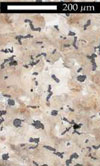Magnesium in the cylinder block
 In the inexorable search for reduced weight, the various alloys of aluminium are most commonly used for high performance gasoline engines. Where peak firing loads are higher, for example as in the case of a modern direct injected diesel engine, this may need to be some form of S.G. (spheroidal graphite) iron. With its excellent flow properties in the molten state, sections can be cast much thinner than other cast irons and thus the disadvantage of a density nearer 7 gm/cm3 can, to a certain extent, be overcome. But when ultra low weight has to be the deciding factor then the only realistic choice is that of magnesium.
In the inexorable search for reduced weight, the various alloys of aluminium are most commonly used for high performance gasoline engines. Where peak firing loads are higher, for example as in the case of a modern direct injected diesel engine, this may need to be some form of S.G. (spheroidal graphite) iron. With its excellent flow properties in the molten state, sections can be cast much thinner than other cast irons and thus the disadvantage of a density nearer 7 gm/cm3 can, to a certain extent, be overcome. But when ultra low weight has to be the deciding factor then the only realistic choice is that of magnesium.
With a specific gravity of 1.74, magnesium is by far the lightest commercial engineering metal. Compared with the alloys of aluminium (specific gravity 2.7) it is around 30% lighter and with a superior strength to weight ratio, can save weight without the loss of any component stiffness. The metal itself has insufficient strength for use in engineering applications but when alloyed with small amounts of zinc, zirconium or some of the more exotic rare earth metals, the grain refinement induced increases its strength to that of many of the aluminium alloys available, save those of the ultra high tensile versions. This is fine for low pressure, gravity sand casting that will subsequently require some form of heat treatment, but when higher volumes require pressure die casting technology, the addition of aluminium to the melt improves its castability. However the presence of aluminium reduces the high temperature performance of the alloy and so other alloying additions – calcium, strontium and rare earth elements have been found to help.
Designing in magnesium however, is not just about changing the melt. Notch sensitivity and the poor response to impact loads require the designer to take greater care at changes of section to minimise the stress raisers. The modulus of elasticity, at around 45 KN/mm2 and lower to that of most aluminium alloys, will also need additional material to maintain the stiffness in critical areas. But the real issue with using magnesium and its alloys in power units apart from its poor corrosion properties, is its performance at elevated temperature and particularly that of high temperature ‘creep’.
Creep is described as the slow plastic deformation of materials under the actions of a constant stress. Not usually a problem with most metals at ambient temperatures it is often easy to forget that as the working temperature of a component increases, so its ability to retain its elastic behaviour reduces. Thus in iron and steel, creep is only an issue at over 400-450 deg C, while that in aluminium alloys is not normally an issue in power unit applications. However in magnesium and its alloys, this phenomenon is of major concern and makes itself known in two ways – that of dimensional stability, and bolt load retention (BLR). Described as the load retained on the bolt when the component is heated to a certain temperature for a specific period of time and then cooled down again, some magnesium alloys have been known to have as little as 45% load retention after 100 hrs at 150 deg C falling to 38% at 177 deg C. Developments in metallurgy in recent times however have produced alloys which have comparable performance to some of the more common aluminium A319 and A380 versions exhibiting something nearer to 80% BLR at these temperatures.
Selecting, designing and making a cylinder block out of a suitable magnesium alloy, is a complex process. Using information on its performance at temperature (fatigue, elongation,
proof stress and creep properties), as well as some of its other traits (casting properties, corrosion resistance and not forgetting its cost), the process is very exacting and fraught with unknowns. Nevertheless, I will still expect to see more of this material in power units in years to come.
Written by John Coxon.